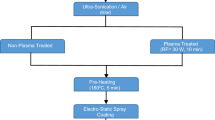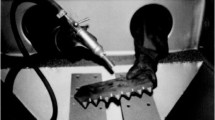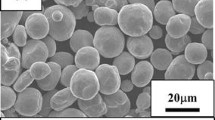Abstract
In the present study, a critical review of the adhesion behavior of plasma sprayed coatings is discussed. A study revealed that substrate preparation, coating technique, surface roughness, solidification mechanism, coating thickness, plasma temperature, the coefficient of thermal expansion, of the top coat and bond coat have a significant influence on the adhesion strength. A great deal of discussion is made on the mechanical strength of the plasma sprayed coatings.
Access provided by Autonomous University of Puebla. Download conference paper PDF
Similar content being viewed by others
Keywords
1 Introduction
The tensile strength is the preliminary requirement of any plasma sprayed coatings. The tensile adhesion test is a widely accepted adhesion test method carried out according to the ASTM C633 standard in the determination of adhesion strength of plasma sprayed coatings [1]. In the test, the coated sample is glued to another similarly coated counterpart and then tested in tension in a universal testing machine. The value of the tensile load, in which the separation of the two coated parts occurs, is registered and transformed into an adhesion value and can be calculated using load divided by area relation. The section at which fracture takes place shows the nature and characteristics of the failure mechanism. In the duplex thermal barrier coating system, the coatings are likely to fail from the bond coat (BC), top coat (TC) or at the BC/TC periphery.
In this paper, a critical review has been done on the adhesion strength of the plasma sprayed coating. Also, a method to conduct adhesion strength of plasma sprayed coatings, parameters affecting the adhesion strength of plasma sprayed coatings, selection criterion in plasma sprayed coatings and works in the related field extensively discussed.
1.1 Selection Criterion in Plasma Sprayed Coatings
The criterion for obtaining good adhesion is based on the following three main rules.
-
(a)
To achieve a satisfactory matching of thermal expansion coefficient, it is essential either to allow the chemical composition of the coating to vary or to employ multilayers of different compositions and properties.
-
(b)
Wettability can be varied by introducing suitable additives that may affect the surface tension of the molten fluid during the enameling period and consequently the contact angle between coating and substrate.
-
(c)
To achieve the best affinity between a coating and a substrate, the former can be subjected to doping to avoid excessive ion diffusion. Care must be taken to prevent or minimize the risk that mechanical properties at the interface may decay as a consequence of the changes introduced into the system because such changes are conducive to more or less marked variations of the chemical and physical properties of the coating.
The adhesion strength is found not to exceed l00 MPa in atmospheric-pressure plasma spraying coatings, where the adhesion mechanism is governed mostly by mechanical anchorage. It has been found that in the case of Low Pressure Plasma Spraying technique of diffusion bonding, or metallurgical bonding, develops a leading mechanism, since the substrate may be heated to an elevated temperature without any corrosion. The use of epoxy resin glue in the adhesion strength above 70 MPa is not recommended by the conventional method. The determination of high adhesion strength using LPPS coating technique reported is difficult [2].
The tensile strength and resistance against shear loads are the criterion for some adhesion experiments [3,4,5,6] although arguments about the experimental techniques and specific outcomes of each one are unambiguous [7,8,9]. Takeda [10] has developed a technique to quantify the adhesion strength. A thick molten glue deposits on the substrate, and then, it is machined to create a test sample similar to that of tensile specimen used in UTM. Finally, it was subjected to the tensile test to determine the bonding strength of the coating.
2 Adhesion Strength of Plasma Sprayed Coatings
Bond strength (adhesive bonding) is one of the critical properties of plasma sprayed coatings. The primary mechanism of adhesion can be described as mechanical keying, physical and chemical diffusive [11,12,13]. According to Sobolev et al. [13], mechanical interlocking improved due to high surface roughness caused due to the solidified droplet formed at the lower part of the splat and established to be a prominent mechanism behind the bond strength.
Another critical factor which is found to affect the bond strength is the co-adherence of the distinct coating grains, which is measured by the degree of flattening grains at the time of deposition, and hence by the velocity and temperature of the particle and that of the temperature of the substrate [14]. It has also been shown with the help of TEM investigations that an amorphous film ranging in thickness from 50–1000 nm is formed at the TC/BC interface. This thin film is a chemical compound which affects the mechanical strength of TBCs [15, 16]. Issues such as the effect of oxidation processes, coating morphology and residual stresses [14,15,16] have to be considered to assess the bond strength of plasma sprayed coatings. It is also found to be dependent on the combination of specimen cleaning and blasting technique, coating materials, coating spray parameters and environmental conditions.
The composition of the substrate, and that of the BC as well, is found to affect the adhesion of alumina formed during the oxidation of bond. With the spalling of alumina, zirconia layer is seen to disintegrate contributing to the failure of TBCs. Segregation, migration and stress generation are the significant matters of concern in the thermally grown oxide (TGO) regions. Due to the concentration, gradient migration of aluminum ions from BC to metal alloy substrate arises. A similar effect has been observed from both the substrate and BC into the TGO. It seems that restricted yttrium ion (Y+) migrated to the alumina improves mechanical bonding; however, impurities in the alumina commonly lead to supplementary stresses, which reduce the adhesion during thermal exposure [17]. High-temperature bulk Y ions diffuse into the YSZ surface and found to destabilize the TC [18, 19] enabling the transformation of Zr phase to monoclinic phase [20] resulting in a detrimental microscopic volume change which may lead to coating spallation. Earlier researchers have also suggested that both neutral and ionic aluminum diffusion into the YSZ layer induces spallation [21]. Diffusion-controlled migration in the TBC is found to promote harmful phase transitions besides enhancing the thermal stresses. Though a concentration gradient is exposed to facilitate the movement via dispersion, the oxygen chemical potential gradient, occurring during oxidation, is found to supply another driving force. Studies have also shown that the potential chemical gradient penetrates into the TC, BC and the specimen (metal substrate). It also affects the reactive oxygen species in all these layers, including those which were initially in the form of carbides, stable oxides, nitrides and sulfides [22,23,24,25]. For example, sulfur is found to segregate the interface, which can prove to be detrimental to the life of TBC. The interfacial sulfur is found to increase the thickness of the TGO layer, decrease the mechanical bonding of the oxide layer to the metal, besides enhancing the transformation of metastable alumina to the α-phase and hence formation at the interface, within the oxide layer and TGO. It also increases the formation of micro-voids and interfacial coarsening. The creation of micro-voids is found to be challenging since they act as stress risers within the oxidation layer [23, 26,27,28,29,30]. Desulphurization of the specimen to less than 1 ppm may assist in preventing this spallation [30,31,32,33]. It has also been found that the existence of other species such as Y and Zr in the BC and substrate might suppress the detrimental effects of sulfur, thus reducing the desulphurization infractions [23, 34,35,36,37]. Further, the scale stresses resulting from the isothermally generated stress during the oxide formation or from uneven cooling stress owing to thermal expansion inconsistency during the thermal cycling process [13].
Sobolev et al. [38] have conducted experiments to analyze the factors which would impact adhesion strength. The magnitude of corrosion product and the degree of the residual stresses is found to be unfavorable for good mechanical bonding. It is found that both should be at the highest levels in the case of fine coatings which possess the second lowest levels of adherence among the IN625 coatings [39]. Residual stresses are also found to be high for graded and intermediate coats, both with little oxide proportion and with extraordinary adhesive strength. It has been observed that ceramic adhesion increases by increasing the particle velocity as well as an increase in the thermal energy of droplet. The poor inter-splat mechanical interaction is found in the case of uneven ceramic coatings. This was the reason attributed to the particle velocities, which are at the lower end of the plasma spray spectrum, thereby resulting in poor mechanical bonding with the substrate. The plasma temperature is also found to be a contributing factor. Fine and mixed composite coatings have small microporosities as compared to granular composite coating and display a very little or no inter-splat separation at all in microhardness test, thereby indicating higher particle velocities. These factors indirectly suggest that oxide content, possibly present as a coagulated surface layer formed before particle impact, is a key factor contributing to low adhesion levels. Another possible reason found to affect the adhesion is the amalgamation of splat size and the substrate surface history. An accusation for the existence of surface peak spacing and splat size ideal combination has also been found [40, 41], where it has been experimentally revealed, increase in the mechanical interlocking comparably with the average surface roughness but is maximum at a specific ratio of grain size to peak topography.
In order to enhance the adhesion strength of ceramics, a range of techniques have been reported, one among is the application of silane and also by tailoring the composition of a ceramic [42]. According to the literature, it has been found that hydrofluoric and phosphoric acid etching followed by silane coupling greatly improve the resin ceramic strength [43,44,45]. A similar kind of work is reported by Romanini-Junior DDSA et al. on adhesive/silane application on bond strength durability to a lithium disilicate ceramic and found promising results [46, 47]. A great deal of review work has been carried out on the effects of lasers on bond strength to ceramic materials and found that the use of lasers significantly improves the adhesion strength of composite to the ceramic surface. The CO2 laser irradiation applied for 10 s to ceramic surfaces found positive and enhanced results [48]. From the above reviews on the adhesion strength, it is recommended to follow the standard protocols intended for specific applications.
3 Conclusions
The following important conclusions can be drawn from the adhesion study of plasma sprayed coatings:
-
1.
Adhesion mechanism is governed mostly by mechanical anchorage, and improved adhesion can be achieved by having high surface roughness.
-
2.
Micro-voids are found to be challenging since they act as stress risers and may reduce the adhesion strength.
-
3.
Plasma temperature during the coating process, corrosion product, blasting technique, coating materials, coating composition, coating spray parameters and environmental conditions has a significant role in deciding the adhesion strength of composite materials. Above said parameters must be carefully designed to have the highest degree of adhesion strength.
-
4.
Secondary process, viz. laser technique and the following standard adhesion protocols intended for specific application can significantly improve the adhesion strength of composite to ceramics.
References
Standard test method for adhesion and cohesion strength of thermal spray coating, ASTM standard C-633-01, ASTM, West Conshocken, PA, USA (2001)
Smeggil, J.G., Funkenbusch, A.W., Bornstein, N.S.: Metal Trans. 17A, 923 (1986)
Pint, B.A., Wright, I.G., Lee, W.Y., Zhang, Y., Prubner, K., Alexander, K.B.: Mat. Sci. Eng. A245, 201 (1998)
Sarioglu, C., Blachre, J.R., Pettit, F.S., Meier, G.H.: Microscopy of oxidation 3. In: Ewcomb, S.B., Little, J.A. (eds.) Institute of Metals, p. 4150. London, United Kingdom (1997)
Sobolev, V.V.: J. Therm. Spray Technol. 9(1), 100–106 (2000)
Gnaeupel-Herold, T., Prask, H.J., Barker, J., Biancaniello, F.S.: Microstructure, mechanical properties, and adhesion in IN625 air plasma sprayed coatings. Mater. Sci. Eng. A 421, 77–85 (2006)
Bahbou, M.F.: J. Therm. Spray Technol. 13(4), 508–514 (2004)
Gawne, D.T., Griffiths, B.J., Dong, G.: Trans. Inst. Met. Finish. 75(6), 205–207 (1997)
Jackson, M., Rairden, J., Smith, J., Smith, R.: J. Met. 33, 23 (1981)
Takeda, K., Ito, Michihisa, Takeuchi, Sunao: Properties of coatings and applications of low pressure plasma spray. Pure Appl. Chem. 62(9), 1772–1782 (1990)
Krishnan, R., Dash, S., Kesavamoorthy, R., Babu Rao, C., Tyagi, A.K., Raj, B.: Laser surface modification and characterization of air plasma sprayed alumina coatings. Surf. Coat Technol. 200, 2791–2799 (2006)
Spraying, T.: Practice, theory and application. Miami FL Am. Weld. Soc. (1985)
Sobolev, V.V., Guilemany, J.M., Nutting, J., Miguel, J.R.: Int. Mater. Rev. 42(3), 117 (1997)
Houben, J.M.: Relationship between the Adhesion of Plasma Sprayed Coatings to the Process Parameters Size, Velocity and Heat Content of the Spray Particles, Ph.D. thesis. Eindhoven University of Technology, Eindhoven, the Netherlands (1988)
Harmsworth, P.D., Stevens, R.: Microstructure of zirconia-yttria plasma-sprayed thermal barrier coatings. J. Mat. Sci. 27, 616–624 (1992)
Bartuli, C., Bertamini, L., Matera, S., Sturlese, S.: Investigation of the formation of an amorphous film at the ZrO2–Y2O3/NiCoCrAlY interface of thermal barrier coatings produced by plasma spraying. Mater. Sci. Eng. A 199, 229–237 (1995)
Bahbou, M.F., Nylén, P., Wigren, J.: J. Therm. Spray Technol. 3(4), 508 (2004)
Berndt, C.C.: Cracking processes in thermally sprayed ceramic coatings. Mater. Sci. Forum 34–36, 457–46 (1988)
Era, H., Otsubo, F., Uchida, T., Fukuda, S., Kishitake, K.: Mater. Sci. Eng. A Struct. Mater. Prop. Microstruct. Process. 251, 166 (1998)
Zhu, Y.L., Ma, S.N., Xu, B.S.J.: Therm. Spray Technol. 8(2), 328 (1999)
Siegman, S., Dvorak, M., Grutzner, H., Nassenstein, K., Walter, A.: In: Lugscheider, E. (ed) Thermal Spray Connects: Explore its Surface Potential, Proceedings of the International Thermal Spray Conference ITSC, p. 823. ASM International/DVS, Dusseldorf, Basel, Switzerland, Germany (2005)
Hadad, M., Marot, G., Lesage, J., Michler, J., Siegmann, S.: In: Lugscheider, E. (ed.) Thermal Spray Connects: Explore its Surface Potential, Proceedings of the International Thermal Spray Conference ITSC, p. 759. ASM International/DVS, Dusseldorf, Basel, Switzerland, Germany (2005)
Trevisan, R.E., Fals, H.C., Lima, C.R.C.: Inf. Tecnol. Chile 11(4), 103 (2000)
Kuenzly, J.D., Douglass, D.L.: Oxid. Met. 8, 139–178 (1974)
Theunissen, G.S.A.M., Winnubst, A.J.A., Burggraaf, A.J.: Surfaces and Interfaces of Ceramic Materials, pp. 365–372. Kluwer (1989)
Schindler, K., Schmeisser, D., Vohrer, U., Wiemhoffer, H.D., Gopel, W.: Sens. Actuators 17, 555 (1989)
Ingo, G.M., Padeletti, G.: Surf. Interface Anal. 21, 450 (1994)
Daloe, J., Boone, D.: Failure mechanisms of coating systems applied to advanced turbine engine components. In: Proceedings 42nd ASME Gas Turbine and Aero Engineering Congress Orlando (1997)
Pint, B.A., GarratReed, A.J., Hobbs, L.W.: Mater. High Temp. 13, 3 (1995)
Pint, B.A.: Oxid. Met. 45(1) (1996)
Hou, P.Y., Prubner, K., Fairbrother, D.H., Roberts, J.G.: Scripta Mater. 40, 241 (1998)
Hou, P.Y., Stringer, J.: Oxide. Met. 38, 323 (1992)
Pint, B.A.: MRS Bull. 19, 26 (1994)
Clyne, T.W., Humphreys, C.J.: Improvements in plasma sprayed thermal barrier coatings for use in advanced gas turbines. Department of Materials Science and Metallurgy. University of Cambridge, Pembroke Street, Cambridge CB23QZ
Grabke, H.J., Kurbatov, G., Schmutzler, H.J.: Oxide. Met. 43, 97 (1995)
Prubner, K., Schumann, E., Ruhle, M.: In: Shores, D.A. et al. (ed.) Fundamental Aspects of High Temperature Corrosion VI, pp. 344–356. Electrochemical Society, Pennington (1996)
Pint, B.A.: Oxid. Met. 48, 303 (1997)
Allen, W.P., Bornstein, N.S.: In: Dahotre, N., et al. (eds.) High Temperature Coatings I, pp. 193–202. TMS, Warren dale, PA (1995)
Meier, G.H., Pettit, F.S., Smialek, J.L.: Mater. Corros. 46, 232 (1995)
Smith, M.A., Frazier, W.E., Pregger, B.A.: Mater. Sci. Eng. A 203, 388 (1995)
Standard test method for adhesion and cohesion strength of thermal spray coating, ASTM standard C-633–01, ASTM, West Conshocken, PA, USA (2001)
Uzun, I.H., MalkocË, M.A., Polat, N.T., Öğreten, A.T.: The effect of repair protocols on shear bond strength to zirconia and veneering porcelain. J Adhes Sci. Technol. 30, 1741–1753 (2016)
Stella, J.P., Oliveira, A.B., Nojima, L.I., Marquezan, M.: Four chemical methods of porcelain conditioning and their influence over bond strength and surface integrity. Dent. Press J. Orthod. 20, 51–56 (2015)
Guimaraes, H.A.B., Cardoso, P.C., et al.: Simplified surface treatments for ceramic cementation: use of universal adhesive and self-etching ceramic primer. Int. J. Biomater. (2018)
AlRabiah, M., Labban, N., et al.: Bond strength and durability of universal adhesive agents with lithium disilicate ceramics: a shear bond strength study. J. Adhes. Sci. Technol. 32(6) (2018)
Romanini-Junior, J.C., Kumagai, R.Y., et al.: Adhesive/silane application effects on bond strength durability to a lithium disilicate ceramic. J. Esthet. Restor. Dent. 30(4) May (2018)
Paula, A., Magalhaes, R., et al.: Simplified surface treatments for ceramic cementation: use of universal adhesive and self-etching ceramic primer. Int. Biomater. (2018)
Garcia-Sanz, V., Paredes-Gallardo, V., et al.: The effects of lasers on bond strength to ceramic materials: a systematic review and meta-analysis. Int. J. PLoS ONE 13(1) (2018)
Author information
Authors and Affiliations
Corresponding author
Editor information
Editors and Affiliations
Rights and permissions
Copyright information
© 2020 Springer Nature Singapore Pte Ltd.
About this paper
Cite this paper
Abhinav, Kustagi, H.K., Shankar, A.R. (2020). Adhesion Strength of Plasma Sprayed Coatings—A Review. In: Reddy, A., Marla, D., Simic, M., Favorskaya, M., Satapathy, S. (eds) Intelligent Manufacturing and Energy Sustainability. Smart Innovation, Systems and Technologies, vol 169. Springer, Singapore. https://doi.org/10.1007/978-981-15-1616-0_8
Download citation
DOI: https://doi.org/10.1007/978-981-15-1616-0_8
Published:
Publisher Name: Springer, Singapore
Print ISBN: 978-981-15-1615-3
Online ISBN: 978-981-15-1616-0
eBook Packages: EngineeringEngineering (R0)




